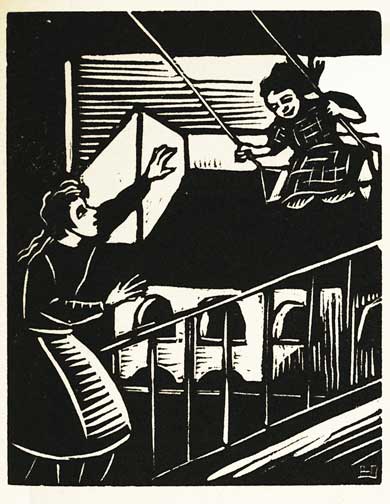The Betty Boyd Dettre Library and Research Center (LRC) at NMWA currently features an exhibition of work showcasing a female voice in a field that many associate with men. Five novels created by Helena Bochořáková-Dittrichová are featured in the exhibition The First Woman Graphic Novelist: Helena Bochořáková-Dittrichová, on view through November 14.

The artist’s novel Z Mého Dětství (From My Childhood), published in 1929, is believed to be the first wordless novel written by a woman. The exhibition hopes to foster discussion about her important contributions to this under-explored genre.
Bochořáková-Dittrichová most likely encountered the popular wordless novels of Belgian artist Frans Masereel while in Paris, where she had received a grant to study printmaking. Masereel focused his novels on socialist themes, such as the working class and the downtrodden. By contrast, Bochořáková-Dittrichová’s wordless novel From My Childhood is about her middle-class upbringing, following her into her adult life. Similarly, other works focus on her life experiences. A 52-woodcut manuscript, which remains unpublished, called Malířka Na Cestách (The Artist on her Journey), features a woman who receives an award to study art in Paris, drawing on the artist’s experience in the city where she became familiar with wordless novels.
Though the novels of Masereel are better known, and are more numerous today, Bochořáková-Dittrichová’s less-polished woodcuts distinguish her. While Masereel’s style features stolid blocks of black and white space that sit against each other, Bochořáková-Dittrichová’s prints are richer in tone, line, and shade. Her figures emerge with a series of small white lines from the expanse of black ink on the page, relying more on hatching and texture to give the appearance of shadow and form. Areas of greater light tones—an open window, for example, or a blouse—seem luminous by comparison.

Helena Bochořáková-Dittrichová’s other works housed and on view in the LRC depict scenes that depart from her personal experiences. Her work explored religion, travel, and history. The library also houses novels by Bochořáková-Dittrichová that feature interplay of image and written narrative. Dojmy Z SSSR (Impressions from the USSR, 1934) features both text and illustration by the artist. However, even when the image is of a historical figure, or a cityscape, her style still features careful slivers of white paper through black ink.
Helena Bochořáková-Dittrichová’s legacy remains to be firmly cemented within our modern understanding of the woodcut. However, with this exhibition, her prints are presented as a tool to help viewers understand her distinct place in the history of the graphic novel.
